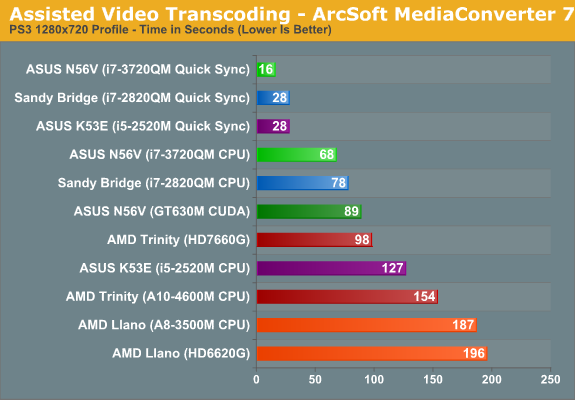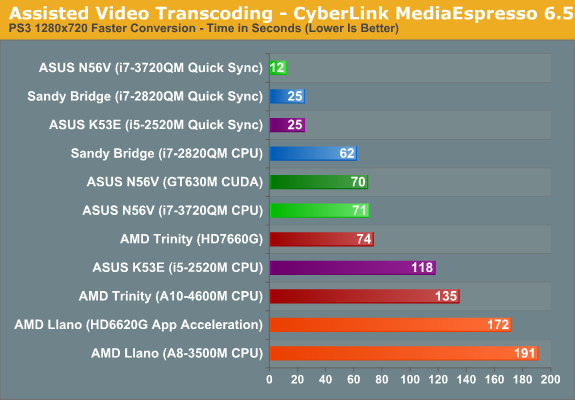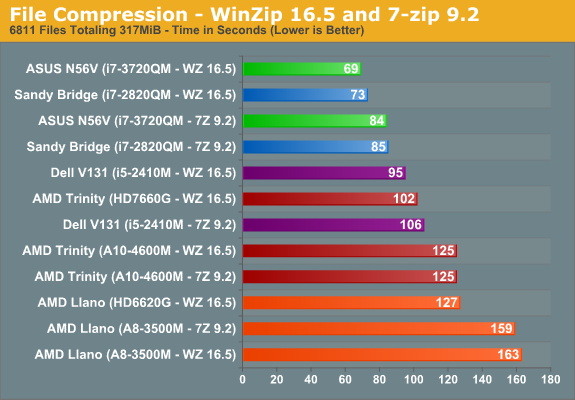The AMD Trinity Review (A10-4600M): A New Hope
by Jarred Walton on May 15, 2012 12:00 AM ESTAMD’s Heterogeneous Computing with Trinity
It’s not all about just CPU or GPU performance, though—or at least that’s what we’ve been hearing from various parties for a while now. The real question is how a platform performs as a whole. There are some tasks where pure CPU performance is what really matters, and there are other tasks where the parallel nature of GPUs pays serious dividends. AMD (and NVIDIA) has been pushing for more applications to make use of the GPU for tasks where it can provide a lot of number crunching prowess.
With Trinity, AMD provided us with a selection of applications that now leverage—to varying degrees—AMD’s App Acceleration, OpenCL, OpenGL, or other tools. For some of these applications, we don’t have any good way of measuring performance across a wide selection of hardware, and for some of those where benchmarks are possible I’ve run out of time to try to put anything concrete together. I don’t want to skip this section entirely, so what follows is a list of the applications, how they benefit from heterogeneous compute, and some general impressions of the application. We also have graphs for a few of the applications where performance seemed to matter the most.
Adobe Flash 11.2—The latest version of Flash continues to add GPU acceleration features, and now there are 3D hooks in addition to the video offload acceleration we first saw with Flash 10.x. There’s not too much of note here, as NVIDIA and Intel also support the latest features of Flash 11.2. Flash works fine on Trinity, but the same goes for Ivy Bridge and various NVIDIA GPUs. If you never saw the Epic Citadel demo for iOS or Android, there’s now a Flash-based version of the same demo that will run in your browser. (Warning: that link can take 10-15 minutes on a decent connection to download all the textures and other data!) Epic Citadel looks just as nice as it did on iOS, but now we need some actual games to take advantage of the tools. Then perhaps we can start looking into benchmarks of browser games or something….
Adobe Photoshop CS6—Photoshop started to take advantage of GPU acceleration back with the CS4 release, using OpenGL to improve performance on certain filters and features. With CS6, Adobe has begun using OpenCL. Fundamentally, I’m not sure how big of a change this represents, but there are quite a few functions in Photoshop that are now supposed to be faster/better with an OpenCL compatible graphics card. There are also two new features that leverage OpenCL; one is Iris Blur, which allows you to mimic depth of field using Photoshop instead of your camera, and the other is Liquify. Unfortunately, I’m by no means a Photoshop expert, so I’m not sure how much the features really help “power users”. I did try doing a benchmark of general Photoshop CS6 performance using the Photoshop Retouch benchmark with and without GPU acceleration enabled; unfortunately, it looks like most of the filters in that action script don’t benefit from the GPU acceleration, as the scores I got were essentially unchanged with or without GPU/OpenCL enabled. Overall, I’ll take the GPU acceleration, but for most of what I do in Photoshop it doesn’t appear to benefit; if you’re interested, you can read more about AMD’s work with Adobe.
GNU Image Manipulation Program (GIMP)—Going along with Photoshop CS6, AMD provided a special preview build of GIMP 2.8. GIMP is sort of the poor man’s Photoshop, as it’s completely free. At present, there are 19 filters that utilize OpenCL to speed of processing, and over the coming months as the release version of GIMP looks to take their new engine live there will undoubtedly be more additions. For now, probably only five of the filters are things I would use (e.g. noise reduction, maybe a light blur). I tested several of these, and there is sometimes an order of magnitude speedup vs. doing the work on just the CPU. The problem is that it also looks like GIMP isn't incredibly well threaded in many of these tasks, putting multicore CPUs at a disadvantage. My biggest complaint isn’t even about performance, though; sadly, I just find the GIMP UI and general performance to be really bad compared to Photoshop. I've tried several times over the years to use GIMP instead of Photoshop, but I’ve never felt comfortable with the tool. If on the other hand you prefer GIMP, hopefully when the current GEGL menu gets integrated into the main program you’ll realize a healthy performance boost.

ArcSoft MediaConverter 7.5—MediaConverter should be a familiar name by now if you’ve been following our reviews, as it’s one of the showcase titles for Intel’s Quick Sync transcoding. When we reviewed Ivy Bridge last month, we found that on Llano at least the version of MediaConverter we had ran slower on the GPU than on the CPU; with Trinity on the other hand, enabling GPU acceleration results in times that are about 60% faster than the CPU alone. That’s a good performance increase, but we’re looking at 154 seconds on the CPU compared to 98 seconds using the GPU. In contrast, dual-core Sandy Bridge on CPU transcoding took 127 seconds and with Quick Sync it only took 28 seconds—a 5X improvement. Quad-core Ivy Bridge was just as impressive, going from 68 seconds on the CPU down to 16 seconds with Quick Sync (4.25X). We’ve been hoping to see something more from AMD’s new Video Codec Engine (VCE), first announced over six months ago with HD 7970, but unless there’s substantial room for improvement it looks like Intel’s Quick Sync will continue to be the fastest transcoding tool for now.

CyberLink MediaEspresso 6.5—This tool is very similar to MediaConverter, and the results are also better this time around. We measured the assisted encode time at 74 seconds compared to 135 seconds on the CPU alone. The 74 second transcode time actually makes Trinity potentially faster than CPU-based transcoding on dual-core Sandy Bridge, but again Quick Sync (25 seconds on SNB, 12 seconds on IVB) remains the fastest way to transcode. Considering both of these tools are apparently using VCE, I have to state that I’m disappointed; with VCE I was expecting performance similar to what Intel is getting with Quick Sync—four or five times faster than CPU-based encoding for the same APU. That Trinity isn't quite twice as fast with VCE is unfortunate; even though there's a decent improvement, Intel is in a completely different category of performance. We’ll have to wait and see if anything more develops with VCE.

Handbrake— Yep, this popular open source video transcoding app is getting an OpenCL facelift. Check out our separate post on it here.
WinZip 16.5—This final application is one that I can see being very useful, assuming we see similar advancements in other compression utilities. WinZip 16.5 now supports OpenCL to improve compression times. We tested by compressing the entire Cinebench 11.5 directory with and without OpenCL enabled, and we also compared the results with 7-Zip. On Trinity, performance improved by about 20%, which is decent; Llano sees an even larger 28% improvement. Meanwhile, Sandy Bridge using CPU-based compression is about as fast as Trinity with OpenCL, and Ivy Bridge is still faster, but the 20% increase for “free” is nothing to scoff at. Unfortunately for WinZip, 7-Zip compressed the same directory to 95MB vs. 108MB in roughly the same time as the non-OpenCL WinZip, and 7-Zip is completely free and doesn't nag you and tell you to buy it. Where WinZip 16.5 is a good proof of concept, what will really help AMD is if all the other compression utilities (7-Zip, WinRAR, etc.) all start using OpenCL or other tools to improve performance.
The majority of the applications continue to focus on video and image manipulation, likely because those are areas where the parallel nature of GPUs can be readily utilized. WinZip on the other hand is an application showing other potential uses for GPGPU and heterogeneous compute. We’d love to see even more adoption of OpenCL and similar tools, but the stark reality is that coming up with new and useful ways of doing this is difficult—if it were easy, everyone would do it! The good news is that giving the creative people of the world more tools with which to work can only help, and we’ll just have to wait and see what else comes out.
There’s another interesting sidebar worth mentioning here. OpenCL is an open standard, and the latest Intel drivers actually install an OpenCL driver on Ivy Bridge and Sandy Bridge. Not surprisingly, not all implementations are created equal, so even with Intel’s drivers we couldn’t enable OpenCL in Photoshop or WinZip; GIMP on the other hand apparently worked okay with OpenCL on Intel—we measured a 5X performance improvement of the Noise Reduction filter with Ivy Bridge. Trinity also came in slightly faster with both leveraging OpenCL, while Intel was nearly twice as fast without.










271 Comments
View All Comments
bji - Tuesday, May 15, 2012 - link
What exactly about the review turned you off from Trinity for HTPC purposes?Was it the good-enough-for-HTPC CPU performance?
The superior GPU performance?
The better power efficiency?
The lower power use?
The cooler GPU?
The lower price (than the i3 you mentioned)?
Honestly just curious about why you so summarily concluded that Trinity wouldn't be a good choice from your HTPC when I can't see anything in the article that would allow you to draw that conclusion.
Unless it was the CPU chart comparison against at 3x as expensive CPU that you would never use in an HTPC anyway?
cjs150 - Wednesday, May 16, 2012 - link
The main purpose will be as an HTPC, video transcoding is very important, look back to Jarred's review, Intel are winning by a large margin.For the case I intend to use as long as TDP is under 50W there are no concerns.
For me the i7-3770T will be the way to go. But you may want to try AMD. If I had built the HTPC last year there would have been no question that AMD would have been the right choice - Atom is/was useless. Maybe next year the table will turn again.
Spunjji - Wednesday, May 16, 2012 - link
Soooo... AMD are good against Atom, so you would have bought them then... but now you're buying an i7 with which they (obviously) cannot compete? That particular argument is a little difficult to follow, unless your requirements have drastically altered. :)To be fair to AMD, most people I know don't do transcodes while at the machine so speed isn't terribly relevant past a certain point, but I understand this may be different for you.
DellaMirandola13 - Tuesday, May 15, 2012 - link
I have really been looking forward to this review, nice to see a reasonably competitive CPU-market. Thank you.I am not a (serious) enthusiast, my best suit is lurking, but I was very excited to learn about the heterogeneous aspect. Is it possible you could elaborate or perhaps link to a comprehensive elaboration on the prospects of heterogeneous computing.
As far as I could tell, it seemed very useful in navigating within GIS-applications (particularly when you have to load roads or other kinds of grids on a map), but that's pure speculation.
Jedibeeftrix - Tuesday, May 15, 2012 - link
I would be interested in a 14" hp sleekbook if it comes with the 25w 4655M APU, as the full 384 shaders would be nice, otherwise I will wait till 28nm APU's arrive in 2013 sporting GCN.Ps test trinity with blender cycles.
Veroxious - Tuesday, May 15, 2012 - link
I am rather baffled by the fact that Ivy Bridge did not bring substantial battery life improvements with it 22nm process. Is it as a result of the trigate transistor tech? By extension when AMD moves to 22nm will it also be trigate seeing that they no longer have their own foundry? Has trigate given the purported benefits that were punted when it was announced, or is it simply a case of the 22nm node not being mature enough?JKnows - Tuesday, May 15, 2012 - link
It would be nice to see those game test in High settings! My personal tests shows in high details settings Llano faster than HD4000, Trinity should be much faster.tipoo - Tuesday, May 15, 2012 - link
This is true. The HD4000 falls further and further behind as you increase the detail settings; that's where AMDs implementation shines.JarredWalton - Tuesday, May 15, 2012 - link
Go look at Mobile Bench: the results for our "High 900p" testing is in there.http://www.anandtech.com/bench/Product/600?vs=580
But just to summarize, at 900p "High" settings, Trinity's lead over HD 4000 grows to 26% in our seven "2012 Suite" games. Also worth note is that Trinity is >30 FPS in three titles (DiRT 3, Portal 2, and Total War: Shogun 2) while Ivy Bridge is >30 FPS only in DiRT 3 (but comes very close in Skyrim).
Alexko - Tuesday, May 15, 2012 - link
"I’d say AMD GPUs as well, but I’m still waiting for a better switchable graphics solution."You mean like Enduro?